If you want to build bigger and stronger legs and are looking for the best hamstring exercises for them, you’ve come to the right place.
Here, we’ll discuss the best exercises to help you build a bigger and stronger hamstring.
Working the entire posterior chain is important, just as it is with the muscles on the anterior side of the body.
Training the back side of the body, including your glutes, hamstrings, calves, and back muscles, helps reduce the risk of injuries (particularly in your knees and hips).
Hamstring exercises are a vital component of any training program. Big and strong hamstrings are part of the foundation of a well-sculpted body.
This article will provide a comprehensive overview of the following:
- Hamstring Anatomy
- Best hamstring exercises to build mass
- Pro Tips
- Workout Plan
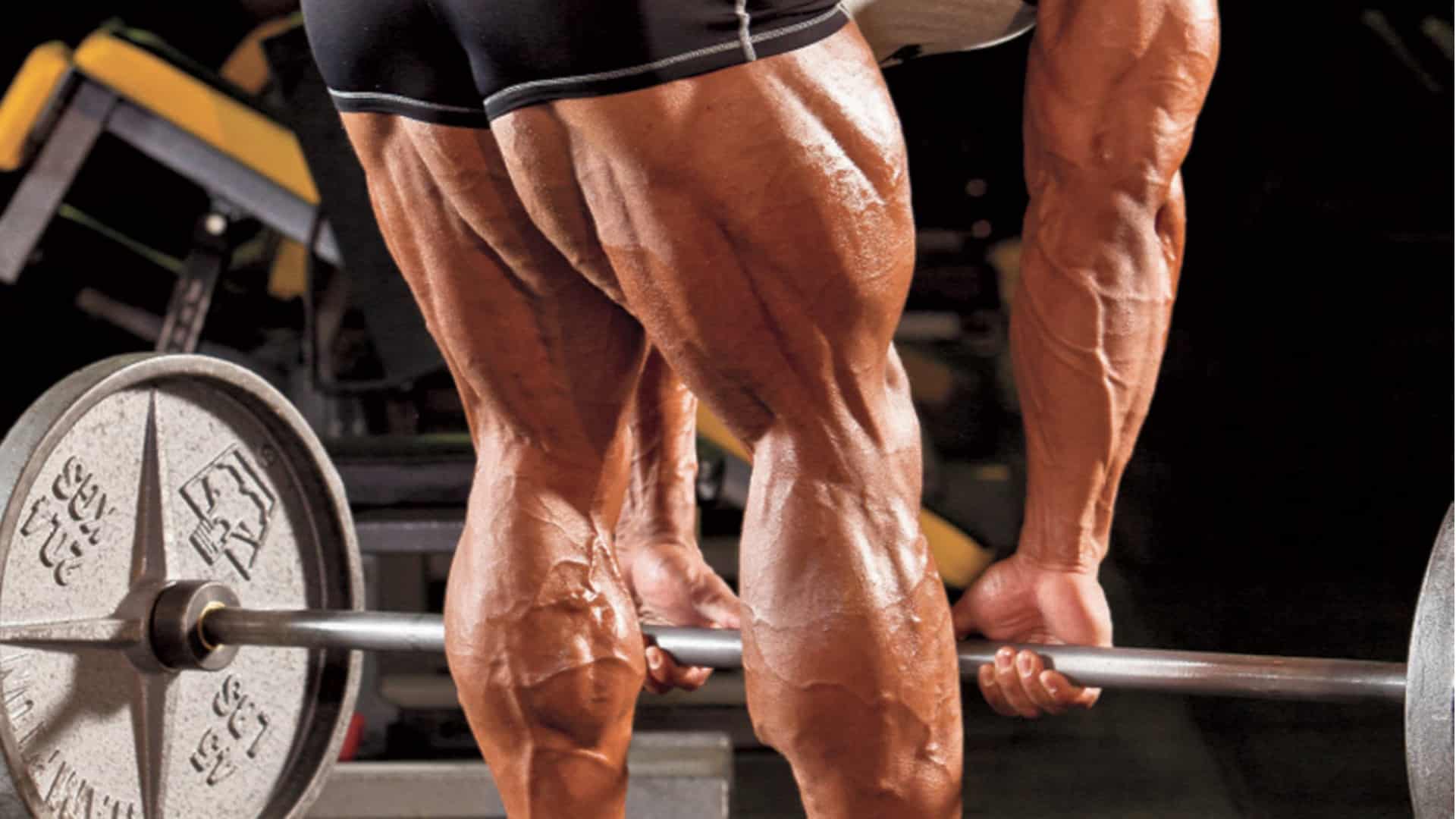
- 15 Best Hamstring Exercises For Mass
- 1. Deadlift
- 2. Stiff-Leg Deadlift
- 3. Leg Curl
- 4. Standing Leg Curl
- 5. Superman
- 6. Hip Bridge
- 7. Good Morning Exercise
- 8. Dumbbell Deadlift
- 9. Flat Bench Hyperextension
- 10. Inverse leg curl
- 11. Lying Dumbbell Leg Curl
- 12. Seated Leg Curl
- 13. Glute and Ham Raise
- 14. Reverse Hamstring Extension
- 15. Kettlebell Swing
- How To Build Hamstrings Mass
- 1. Sets And Reps of Hamstrings Per Week
- 2. Frequency
- 3. Intensity
- 4. Progression
- 5. Recovery
- Hamstring Workout Plans
- 1. Beginner Hamstring Workout Plan
- 2. Intermediate Hamstring Workout
- 3. Advanced Hamstring Workout
- The Anatomy of the Hamstrings
- FAQs
- What exercises work the hamstrings?
- How can I build my hamstrings at home?
- Are squats good for hamstrings?
- Takeaways
15 Best Hamstring Exercises For Mass
These 15 best hamstring exercises for building mass and strength in your hamstrings will ensure that your leg muscles can do their part in supporting the stability of your body throughout your training.
1. Deadlift
The deadlift is the King of all exercises. It is the best exercise for posterior chain muscle strengthening.
Deadlift works your whole body, including the Lower back, upper back, arms, legs, and buttocks. It is the biggest muscle builder, recruiting more muscle motor units than any other exercise.
This exercise can be performed using either a barbell or a pair of dumbbells. Must add this exercise to your hamstring workout to build a Stronger and bigger legs.
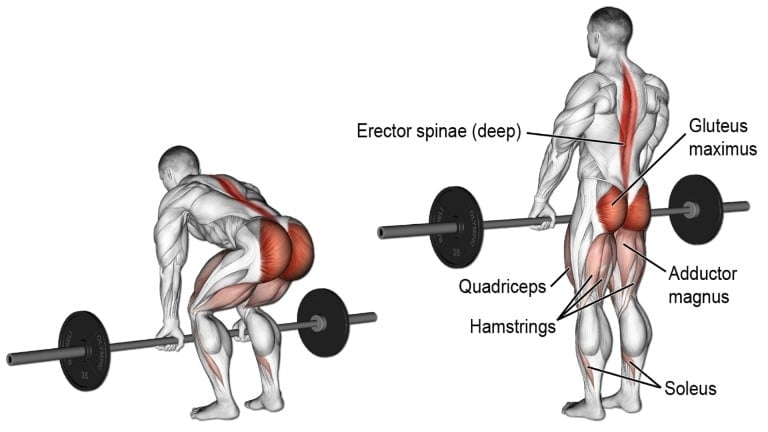
How To Do
- Grab the barbell using an underhand grip with one hand and an overhand grip with the other hand.
- Now raise the bar from the ground using your hamstrings and glutes.
- You should keep your legs slightly bent, back straight and head looking up.
- The initial movement is provided by your heels, not your toes or elbows.
- Raise it to the point where your body is erect. Do not hyperextend your body as the weight shifts to the lumbar spine.
- Hold the bar for a moment at the top of the lift.
- Now lower the bar slowly at a steady, slow pace by bending at the hips first and then at the knees.
Tips
- If a deadlift is performed incorrectly, it can cause more harm than good. Keep the back straight at all costs.
- Remember to keep your back as straight as possible and contract your back and hamstrings.
- Lower back muscles take a long to recuperate; hence, heavy deadlifts will do the job once a week.
- Go full range of motion and keep form correct.
- Avoid jerky movements and keep them controlled.
2. Stiff-Leg Deadlift
If you’re looking for straightforward hamstring exercises to build mass and strength, then stiff leg deadlift is a great staple exercise to get you started.
When performed correctly and with a full range of motion, this exercise strengthens your hamstring, gluteals and calf muscles.
The stiff-leg deadlift for hamstrings requires a lighter weight than that used during traditional powerlifting for strengthening the lower back.
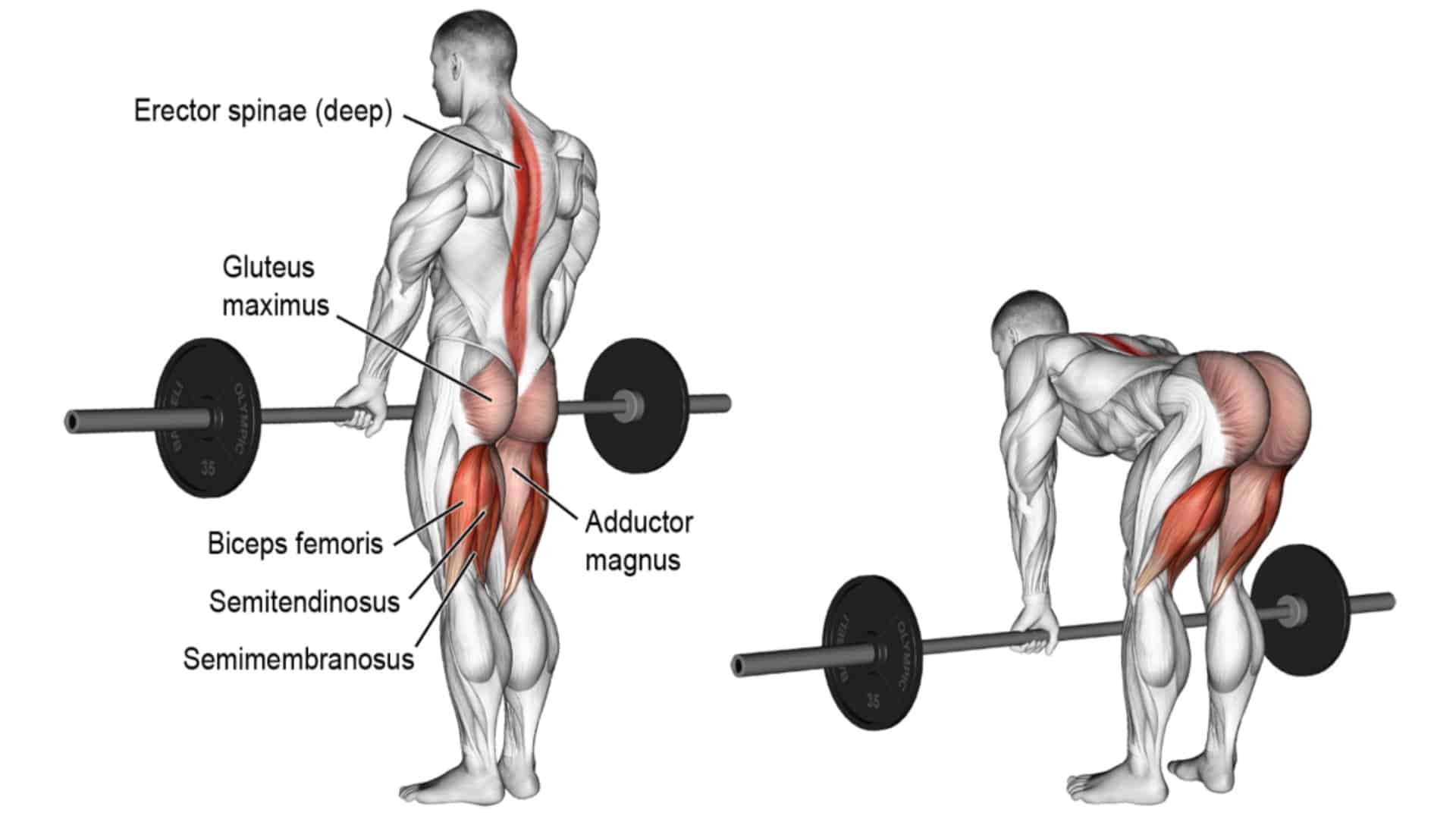
How To Do
- Grasp a barbell using a shoulder-width pronated (overhand) or mixed grip.
- Keeping your back straight, head up, and hips low, lift the barbell into a standing position.
- Flex your knees a little and push your hips backward, and slowly lower the barbell down the front of your legs.
- Descend until you feel a mild stretch in your hamstrings.
- Exhale as you pull the barbell back up to the starting position by pushing your hips forward.
Tips
- Keep your knees stiff, your back and arms straight, and your head up.
- Do not allow the bar to drift away from your body during the lift. Keep the barbell close to your body.
- Keep soft knees and ensure the movement occurs primarily at your hips.
- Lower the weight until your hamstrings reach full stretch without rounding your spine.
3. Leg Curl
Leg curl or hamstring curl exercises are the best way to build muscle mass in the hamstrings (back of the thigh muscles). This exercise is performed on a leg curling machine.
The position of the toes shifts the emphasis of the hamstring muscle.
- Pointing your toes straight targets all three hamstring muscles.
- Pointing the toes inward emphasizes the inner hamstrings (semimembranosus and semitendinosus),
- Meanwhile, pointing the toes outward focuses effort on the outer hamstrings (biceps femoris).
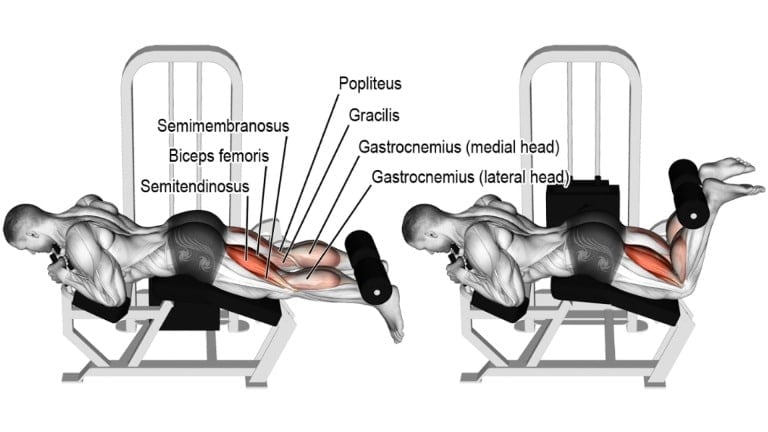
How To Do
- Lie face down on a lying leg curl machine and extend your legs straight.
- Position your legs under the support pads.
- Curl the weight by bending your knees, and raise your heels toward your buttocks.
- Hold the handles or bench to prevent yourself from lifting off the bench. Keep the movement smooth.
- Lower the weight to the starting position.
Tips
- Keep your spine straight, and do not raise your chest upward.
- Go full range. Bend your knees as far as possible during the upward phase.
- Stop a few degrees short of full extension at the bottom to keep tension on the hamstrings and minimize stress across the knee joint.
- Avoid jerky movements.
4. Standing Leg Curl
When doing a hamstring exercises for mass, there are plenty of single leg exercises you can add to correct potential imbalances.
In contrast to the lying leg curl, the standing leg curl is performed one leg at a time, which helps muscle isolation and focus. Resistance is fairly uniform.
It also reduces muscle imbalances, increases muscular hypertrophy, and enhances the endurance of your glutes and hamstrings.
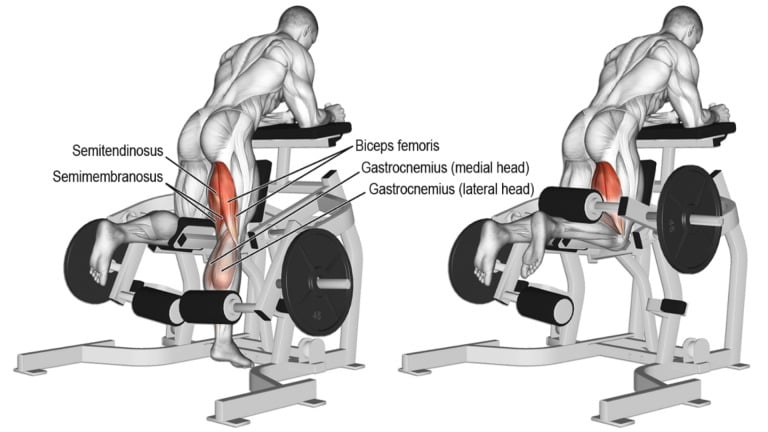
How To Do
- Standing facing the machine, slightly to one side of it.
- Hook one heel under the roller pad, and support your weight with the other leg.
- Curl the weight by bending your knee, raising your heel toward your buttock.
- Hold for a couple of counts and slowly lower the weight back down to the start position.
- Finish the set, then switch legs and repeat.
Tips
- Stretch your hamstrings before and after this exercise to reduce the risk of injury.
- Keep your back straight and perform with controlled motion.
5. Superman
Superman is one of the best exercises to strengthen your posterior muscles like, hamstring, glutes and back muscles.
If done regularly, the Superman exercises may also help alleviate lower back pain that is related to weak back muscles and glutes.
You should add this hamstring exercise to your home workout arsenal to increase the mass and strength of your legs and back.
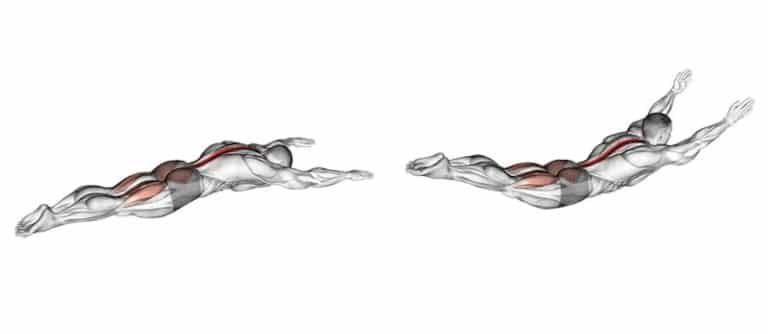
How To Do
- Lay with your stomach flat on the ground. Extend your arms in front of you with your palms down.
- Lift your head and raise your arms and your chest off the ground as far as possible.
- Bend your legs and lift your thighs off the ground as much as possible. (Try to make a big “U” with your back.)
- At this point, you should feel your back muscles, glutes, and hamstrings tighten.
Tips
- Try holding for only five or 10 seconds at your first time, and work up to 30 seconds in future workouts.
- Do not hold your breath. Breathe regularly.
6. Hip Bridge
When you spend most of your day sitting, your glute muscles can weaken, while the hip flexors in the front of your thighs can shorten, making them feel tighter.
However, when you practice glute bridges regularly, you will target your glutes, quads, hamstrings, and lower back muscles. These muscles are meant to hold your body upright.

How To Do
- Lie face up on the floor, with your knees bent and feet flat on the ground.
- Keep your arms at your side with your palms down.
- Lift your hips off the ground until your knees, hips, and shoulders form a straight line.
- Squeeze those glutes hard and keep your abs drawn in so you don’t overextend your back during the exercise.
- Hold your bridged position for a couple of seconds before easing back down.
Tips
- Do not push with your arms.
- Don’t overextend your back during the exercises. This may cause lower back pain.
- Hold a weight plate on your lap to make the Hip bridge exercise more difficult.
7. Good Morning Exercise
The good-morning exercise is one of the best bodyweight hamstring exercises for muscle mass and strength.
It is known as a good morning because of the movement in the erector spinae, which resembles the rise out of bed to stretch.
You will put your glutes and hamstrings through a large range of motion, providing better muscle-building potential and increasing your posterior strength.

How To Do
- Stand holding a stick (or Weight) on the back of your shoulders, grasping the stick at each side.
- You can also perform the exercise as in the bodyweight version.
- Keeping your knees slightly flexed and your back and neck neutral, inhale as you flex your hips to lower your torso until it is close to or fully horizontal.
- Exhale as you raise your torso back up to the starting position by extending your hips.
Tips
- Keep your back and neck neutral throughout the exercise.
- It is recommended that the lifter avoid rounding (flexing) or rotation (twisting) at any point during the movement.
- Keep the movement slow, the form strict, and the weight light.
8. Dumbbell Deadlift
The Dumbbell deadlift is the best variation of the classic barbell deadlift. This is one of the best exercises to add mass in hamstring and other posterior chain muscles.
The Deadlift exercise can be performed using either a barbell or a pair of dumbbells. One of the biggest benefits of using dumbbells for deadlifts is that they increase the range of motion you can work in comparison to barbell deadlifts.

How To Do
- Place a dumbbell in front of you. Grab the Dumbbells with each of your hands.
- Raise the dumbbell from the ground using your hamstrings and glutes.
- You should keep your legs slightly bent, back straight, and head looking up.
- Raise it to the point where your body is erect. Do not hyperextend your body as the weight shifts to the lumbar spine.
- Hold the bar for a moment at the top of the lift.
- Then, lower the dumbbells slowly at a steady, slow pace by bending at the hips and then at the knees.
Tips
- Do not go through half of the exercise, complete the lift.
- Remember to keep your back as straight as possible.
- Lower back muscles take a long time to recuperate. Therefore, heavy deadlifts should be done once a week.
- Avoid jerky movements and keep motion controlled.
9. Flat Bench Hyperextension
Flat bench hyperextension exercise directly hits the erector spinae, hamstring and gluteus muscles and helps in building a strong back and hamstrings.
To make Hyperextensions difficult, you can also hold a plate to your chest or behind the head for additional resistance. If the exercise becomes easy, you can do a lot of reps.
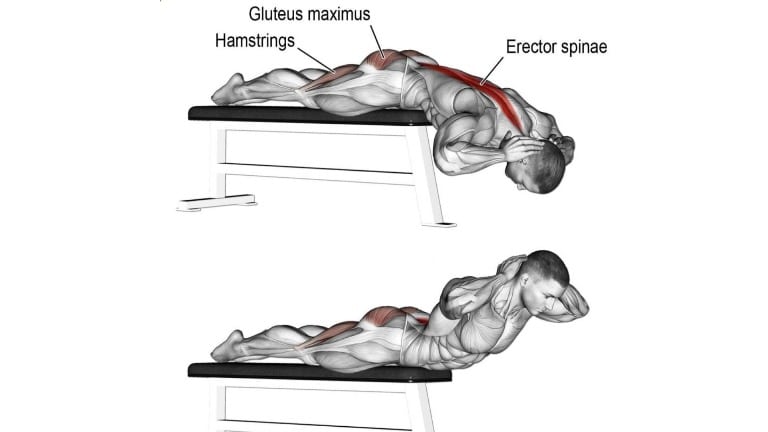
How To Do
- Lie face down on a flat bench with your torso extending off the end.
- Hook your heels under the bench to prevent yourself from falling forward.
- Place your hands on your chest (or behind your neck) and bend down through your waist.
- Return to the start position, but avoid extending beyond the body level.
Tips
- Avoid hyperextension beyond the body level.
- Keep movement always under control, without letting gravity take you down faster.
10. Inverse leg curl
If you’re looking for a way to get more creative with hamstring exercises for mass, why not try Inverse leg curl.
The inverse leg curl is also known as the manual hamstring curl, bodyweight hamstring curl, and the Norwegian or Nordic hamstring curl.
It is an unconventional hamstring exercise that isn’t common, but that doesn’t make it any less effective.
The inverse leg curl (bench support) uses your bodyweight to work the hamstrings and is just as, if not more, challenging to do.

How To Do
- Get on your knees and anchor the back of your heels under a bench or a barbell.
- Cross your arms over your chest, or you can keep them by your sides.
- Inhale as you allow your body to slowly fall forward, controlling the descent as much as you can with your hamstrings.
- At the bottom of the movement, catch your body with your arms and lower your torso to the floor, as if performing a knee push-up.
- Exhale as you push your torso back up and off the floor just enough until your hamstrings can take over and pull your body back up to a vertical position.
Tips
- Use your arms as minimally as possible.
- To protect your knees, use a mat.
11. Lying Dumbbell Leg Curl
The dumbbell leg curl is useful when you don’t have access to a leg curl machine.
It is one of the best isolation exercises to build mass and strength in the hamstring muscles.
The most difficult element of the dumbbell leg curl exercise is learning how to hold the dumbbell securely between your feet. This becomes increasingly trickier the heavier the dumbbell becomes. Therefore, start light until you get used to the exercise.
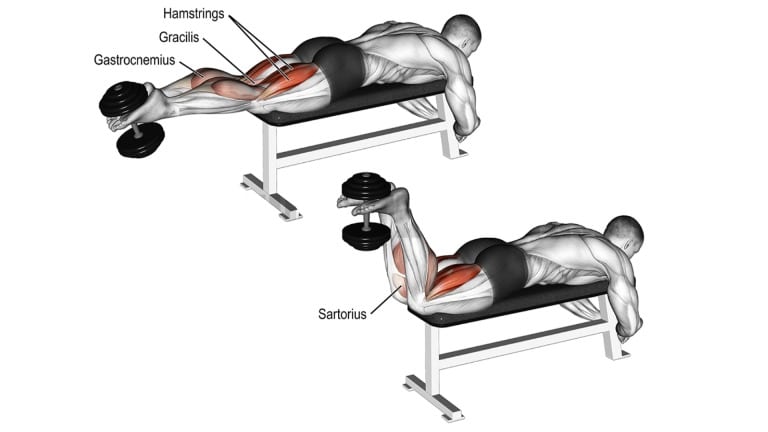
How To Do
- Place a dumbbell between your feet and lie down on a flat bench with your legs extended.
- Hold on to the edge of the pad or the legs of the bench for stability.
- Slowly bring the weight up by flexing your knees until your lower legs are just short of vertical.
- Slowly lower the dumbbell back to the starting position.
Tips
- Do not curl the dumbbell until you are confident that it is being held securely between your feet.
- Focus on moving the weight with your hamstrings, utilizing a full range of motion.
- Use a light dumbbell to get the form down before attempting heavier dumbbell leg curls.
12. Seated Leg Curl
The seated leg curl is a variation of the leg curl and an exercise used to isolate the hamstrings and to add mass and strength.
Not only will this exercise increase your lower body strength, but it will help you prevent injury and improve your performance in other exercises.
You can also perform seated leg curls unilaterally. Simply decrease the weight, let one leg rest, and complete each rep with the same form as the standard seated hamstring curls.

How To Do
- Sit on a seated leg curl machine with your knees just past the bench and your ankles placed on the ankle pad.
- Hold the handles to support your body.
- Curl your lower legs under you by flexing at the knees to bring your feet as close to the bottom of the bench as possible.
- Hold this position for a second and squeeze your hamstrings hard.
- Return your feet to the starting position. Repeat the desired number of repetitions.
Tips
- Keep the movement slow and controlled.
- Try to resist the rising of the lever.
- Keep your back pressed firmly against the back support.
- Ensure the head does not just forward excessively.
13. Glute and Ham Raise
The glute-ham raise focuses on the hamstrings, but the tension it creates on the backside of the body irradiates all the way up the chin.
That means that the glutes get involved as well (as the name of the exercise would imply), along with the spinal erectors, which run from the pelvis all the way up to the neck.
If your gym has this apparatus, you should add it to your hamstring exercises arsenal, which help to build mass and strength in your legs.

How To Do
- Position yourself on a glute-ham raise bench with your thighs resting on the rounded pad and your ankles in the ankle pads and feet pressed firmly on the foot plate.
- Bend forward from the hips so that your torso hangs down toward the floor.
- Start the move by extending at the hips. Once your torso is in line with your thighs.
- Curl your body up from the knees until your thighs and torso are upright.
- Squeeze hamstrings and glutes hard at the top to maximize contraction.
Tips
- Make sure you feel the stretch and contract in both areas (upper and lower hamstring).
- Keep the movement slow and controlled.
14. Reverse Hamstring Extension
Reverse hyperextensions, exercise comes from the world of powerlifting but is now widely accepted as an excellent general strength, conditioning, and bodybuilding exercise.
In the concentric phase, by isolating the glutes and hamstrings, weighted reverse hyperextensions allow you to build up flexibility, power, and strength in them without creating soreness elsewhere.
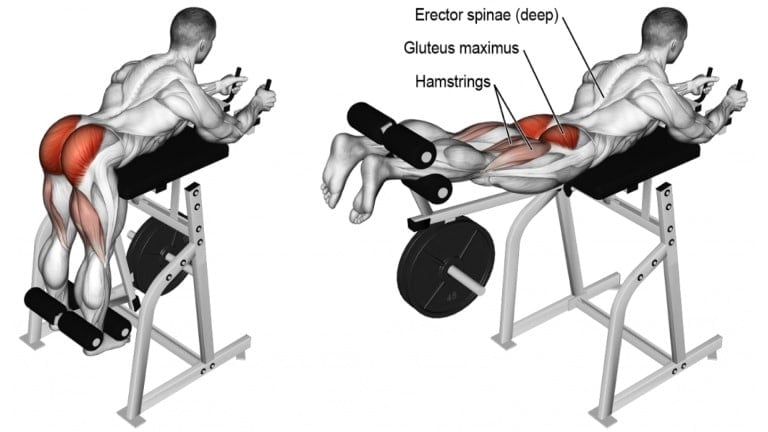
How To Do
- Lie facedown on a hyperextension bench. Hold the support hands with your arms to support your torso on the pad.
- Your hips and legs should hang off the end of the pad at a 90-degree angle.
- Extend at the hips to raise your legs up to parallel with the floor.
- Hold this position for a second, then reverse the motion to lower your legs back to the starting position.
Tips
- Maintain full control of the movement. Do not allow the build-up of momentum.
- Your hips should be set at the end of the pads so that they can flex freely without the lower back extending and flexing excessively.
15. Kettlebell Swing
Finally, if you’re looking for one more effective hamstring exercise for mass and strength, try the kettlebell swing.
Kettlebell swings are based on the deadlift movement pattern and hit almost every muscle in the body, especially those of the posterior chain, resulting in a stronger back and hips. This will be very helpful to your goals of increasing glute and hamstring hypertrophy.
The kettlebell swing can be used in cardio circuits and to strengthen your posterior chain muscles.
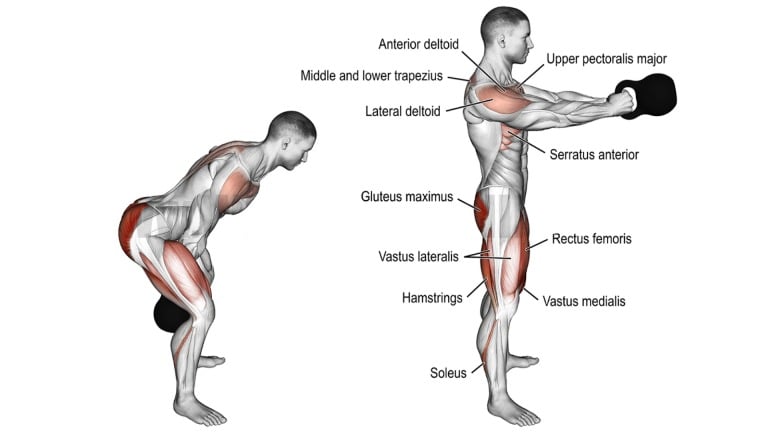
How To Do
- Place your feet slightly wider than shoulder-width apart and stand in a spine-neutral position.
- Your arms in front of your body and use both hands, palms down, to hold the kettlebell.
- With your knees bent slightly and hips thrust back, adopt a squat like position, but refrain from going as far down.
- Drive your hips forward while swinging the kettlebell forward and up to shoulder height.
- You should feel your hips and glutes engaging in this motion.
- The kettlebell should then be lowered back between your legs and the swinging motion repeated for 12–15 repetitions.
Tips
- Keep your head up, your core tight, your back straight, and your feet flat.
- Do not swing the kettlebell too high, stop when your arms are parallel with the floor.
How To Build Hamstrings Mass
Structuring a hamstring workout program involves several key factors to consider, including exercise selection, volume, frequency, and progression.
Here are some tips for structuring an effective leg workout program:
The hamstrings are responsible for extension of the hip, and flexion of the knee. Or, to put it more simply, they bend the knee, and straighten the hip.
So, any exercises that involve knee flexion and hip extension work the hamstring muscles.
1. Sets And Reps of Hamstrings Per Week
For building muscle mass, how much total training volume per week is more important than how often you train
Of course, the number of sets and reps will be determined based on your fitness journey, but here is a great starting point:
Sets
- Beginners (with a year or less of training) should aim for about 12 weekly sets.
- An Intermediate trainee (with two to four years of training) can increase the volume to 16 sets per week.
- An advanced trainee (four or more years of training) may be able to get in up to 20 weekly sets.
Reps
The best rep ranges and loads to work with.
- For muscle endurance: 15-20+ with a light load
- For muscle strength: 6–8 reps with a heavy load
- For muscle hypertrophy (increased muscle size): 8–15 reps with moderate load
Studies show that training with higher weekly sets (HWS) leads to greater strength gains than lower weekly sets (LWS). This applies to both multi-joint and isolation exercises
2. Frequency
How often you perform leg workouts depends on your fitness level and goals.
- For beginners, 1-2 leg workouts per week are recommended,
- While advanced lifters may benefit from 2-3 leg workouts per week.
3. Intensity
- For hip hinge movements, you should do between 75 and 80% of your 1RM for anywhere between 6 and 10 reps.
- For hamstring curls, 60-70% of your 1RM for 10–15 reps should do the job nicely.
4. Progression
Progression refers to gradually increasing the weight, reps, or sets over time to promote muscle growth and adaptation.
This can be achieved by increasing the weight lifted, increasing the number of reps performed, or decreasing rest time between sets.
5. Recovery
Adequate rest and recovery are important for muscle growth and injury prevention. Make sure to allow for at least one day of rest between leg workouts, and prioritize sleep, nutrition, and hydration to support recovery.
Hamstring Workout Plans
If you want to create a balanced leg workout, add two or three hamstring exercises to each routine.
Before you get started with a hamstring workout, make sure you warm up properly. You could try walking on a treadmill with an incline, climbing stairs, or riding a bike to get your blood flowing.
These types of movements warm up your hamstrings specifically. Then do a few warm-up sets with lighter weight or just your bodyweight before doing the exercises with heavier weight.
1. Beginner Hamstring Workout Plan
If you’re new to lifting weights, don’t worry. This beginner-friendly hamstring workout routine is a great place to start.
When this gets easy, choose a heavier free weight. After you’ve upped your weight several times and feel strong in the movements below, move on to the intermediate routine. Until then, you can follow this beginner hamstring workout plan.
| Exercise | Sets | Reps Range |
|---|---|---|
| Hip Bridge | 4 | 8–15 |
| Dumbbell Deadlift | 4 | 8–12 |
| Leg Curl | 3 | 8–10 |
2. Intermediate Hamstring Workout
If you are an intermediate level or have outgrown the beginner routine, try the intermediate hamstring workout routine below.
| Exercise | Sets | Reps Range |
|---|---|---|
| Deadlift | 4 | 8–10 |
| Standing Leg Curl | 4 | 8–12 |
| Glute And Ham Raise | 3 | 8–10 |
| Good Morning | 3 | 12–15 |
3. Advanced Hamstring Workout
If you are an advanced-level athlete or have already completed the beginner and intermediate hamstring workouts, try the advanced routine.
Here, you’ll challenge your balance, stability, and strength more.
- Stiff-Leg Deadlift: 4 sets of 8–15 reps.
- Seated Leg Curl: 4 sets of 8–12 reps.
- Reverse Hamstring Extension: 4 sets of 8–12 reps.
- Superset with above Kettlebell Swing: 3 sets of 8–10 reps
The Anatomy of the Hamstrings
The hamstrings are a group of muscles in the back of the thigh. The hamstrings, run from the lower portion of the thigh at the knee joint, and they run up to the base of the glutes.
The hamstring is made up of three primary muscles:
- Biceps femoris passes behind the outer aspect of the thigh to attach to the head of the fibula bone, just below the knee.
- Semimembranosus passes behind the inner aspect of the thigh, attaching to the upper tibia bone behind the knee.
- Semitendinosus passes behind the Inner aspect of the thigh, attaching to the upper tibia bone adjacent to semimembranosus.
These muscles work together to flex the knee and extend the hip through movements and exercises such as the leg curl as well as deadlifts.
Furthermore, these muscles work in conjunction (as mentioned) with the lower back and glutes to provide lateral rotation, extension, abduction and stability while bending, lifting and twisting.
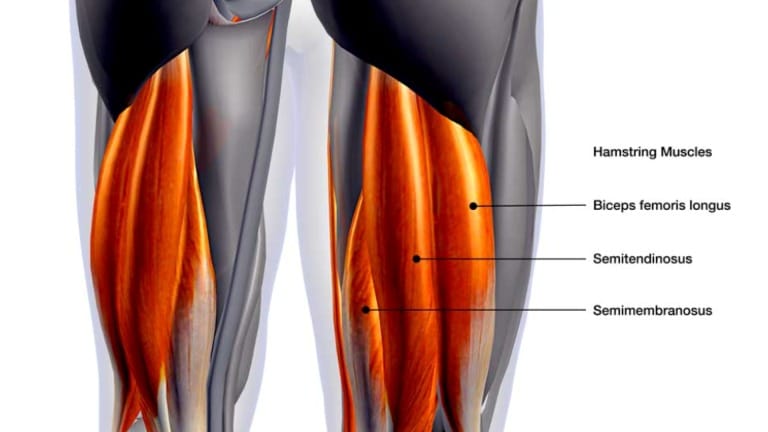
FAQs
What exercises work the hamstrings?
The exercises that involve knee flexion and hip extension work the hamstring muscles.
Running, walking, cycling, and hiking are just a few activities that utilize the hamstring muscles located on the back of your thigh. During movement, the hamstrings flex the knee and extend the hip.
The best exercise for hamstrings is the stiff leg deadlift and several other hamstring exercises that are very effective and may work better for you are: Romanian deadlifts, good morning and leg curls.
How can I build my hamstrings at home?
There are many hamstring exercises you can do with your bodyweight at home. You can also work your hamstrings at home with bands, dumbbells, or any other equipment you may have.
It is important to challenge yourself enough that you can make progress within a few repetitions of failure, and increase the challenge over time.
Are squats good for hamstrings?
Yes, squats do train the hamstring muscles, but not to a significant degree. The primary muscle group worked during the squat is the quadriceps, but the hamstrings are also activated.
Takeaways
Strong hamstring muscles are a must-have for lifters who want to build muscular thighs while also lifting heavier weights.
Don’t neglect your hamstrings! Incorporate these 15 top-rated hamstring exercises into your leg routine for maximum strength, size, and performance gains.
Let us know how these exercises are working for you.

Manish is a NASM-certified fitness and nutrition coach with over 10 years of experience in weight lifting and fat loss fitness coaching. He specializes in gym-based training and has a lot of knowledge about exercise, lifting technique, biomechanics, and more.
Through “Fit Life Regime,” he generously shares the insights he’s gained over a decade in the field. His goal is to equip others with the knowledge to start their own fitness journey.
